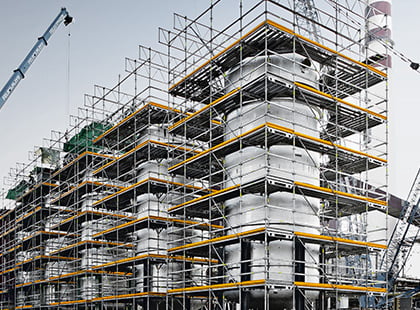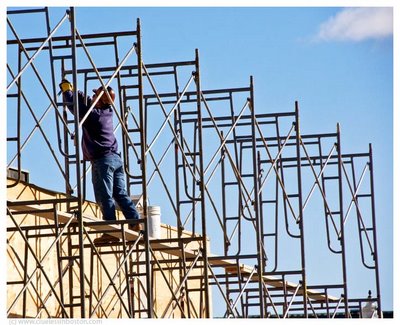Discovering the Different Sorts Of Scaffolding Made Use Of in Building And Construction Jobs
The building and construction sector depends heavily on different types of scaffolding to satisfy particular job demands, each offering unique benefits and applications. Typical structure scaffolding gives a strong structure for basic tasks, while suspended scaffolding is necessary for job on high-rise structures. Various other options, such as system and rolling scaffolding, satisfy effectiveness and mobility, respectively. Additionally, the cantilever variant confirms invaluable in city atmospheres where room is constricted. Comprehending the subtleties of these scaffolding types is vital for maximizing security and efficiency on building websites, triggering a closer examination of their unique features and applications.

Conventional Structure Scaffolding
Typical framework scaffolding is one of one of the most commonly utilized approaches in the construction industry because of its robustness and versatility. This system is composed of horizontal and upright frames that are put together to create a stable platform for workers and materials. The main components include upright messages, straight ledgers, and angled dental braces, which together supply a strong framework that can sustain significant loads.
One of the key benefits of standard frame scaffolding is its versatility to different building tasks, ranging from household structures to large industrial structures. The modular style enables for simple setting up and disassembly, making it efficient for both long-term and temporary projects. Additionally, the system can be personalized in elevation and size, accommodating different building styles and website conditions.
Safety is vital in scaffolding applications, and traditional framework systems are outfitted with guardrails and toe boards to avoid drops and ensure employee protection. Regular inspections and adherence to security laws are critical in keeping the stability of the scaffold (Scaffolding). Overall, standard framework scaffolding remains an essential option in the construction sector, giving a trusted system for labor and boosting general job effectiveness

Suspended Scaffolding
Put on hold scaffolding provides a special service for building and construction tasks that call for accessibility to raised surfaces, specifically in situations where standard framework scaffolding might be unwise. This kind of scaffolding is usually suspended from the roof or top levels of a structure, using a system of ropes, systems, and sheaves to create a working room that can be gotten used to various elevations.
Among the main advantages of put on hold scaffolding is its versatility. It can be quickly rearranged or lowered to fit modifications in building and construction demands, making it excellent for jobs such as home window installment, façade work, and upkeep on skyscraper buildings. Furthermore, the very little footprint of suspended scaffolding enables much better use ground space in city environments, where room is commonly limited.
Safety is an important factor to consider in using suspended scaffolding. Correct rigging and securing systems have to be used to guarantee security and prevent accidents. Operators must likewise be learnt the safe use this devices. Generally, suspended scaffolding provides a effective and effective service for accessing hard-to-reach locations in various construction try this out scenarios, boosting both productivity and safety on website.
System Scaffolding
System scaffolding, usually considered as a modern-day solution in the scaffolding market, consists of pre-engineered parts that can be promptly assembled and adjusted for various construction projects. Scaffolding. This kind of scaffolding is characterized by its modular layout, which permits flexibility and performance on work websites, accommodating architectural demands and various elevations
Typically made from high-strength steel or aluminum, system scaffolding uses boosted resilience and security. The components consist of vertical posts, horizontal journals, and angled dental braces, which interconnect securely, ensuring a durable structure. The layout usually integrates standardized installations, streamlining assembly and disassembly processes, thereby decreasing labor time and costs.

Rolling Scaffolding
Rolling scaffolding is a versatile option to conventional fixed scaffolding, made for flexibility and simplicity of usage on building websites. This sort of scaffolding contains a system sustained by frames with wheels, permitting workers to easily transfer it as needed. The flexibility function substantially enhances performance, as it lessens downtime connected with setting up and taking apart taken care of scaffolding.
Normally constructed from light-weight materials such as light weight aluminum or steel, rolling scaffolding offers a durable yet portable service for jobs requiring frequent repositioning - Scaffolding. It is especially beneficial in jobs such as painting, drywall setup, and electric job, where access to numerous elevations and areas is necessary
Safety and security is paramount in rolling scaffolding style, with features such as securing wheels to avoid unintended motion when being used, and guardrails to shield workers from drops. Additionally, lots of designs are adjustable in height, fitting various project demands.
Cantilever Scaffolding

The design of cantilever scaffolding typically includes utilizing braces or arms secured to a building or framework, enabling the system to expand external safely. Safety and this page security is extremely important; thus, these scaffolds should be crafted to hold up against environmental conditions and different lots. Regular evaluation and maintenance are important to make sure architectural integrity and employee security.
Cantilever scaffolding is preferred for its flexibility and effective use of area, making it a preferred option in city atmospheres where area restraints are typical. Additionally, it facilitates simpler access to high elevations, inevitably adding to the overall performance of construction tasks. Just like all scaffolding types, correct training and adherence to safety and security standards are crucial for workers using cantilever scaffolding.
Verdict
Traditional framework scaffolding supplies security, while put on hold scaffolding uses adaptability for raised tasks. System scaffolding promotes fast assembly, and rolling scaffolding improves movement for varying job atmospheres.
Standard framework scaffolding supplies a tough foundation for basic jobs, while put on hold scaffolding is necessary for job on skyscraper frameworks.Moving scaffolding is a versatile choice to typical set scaffolding, designed for flexibility and simplicity of use on building sites. As with all scaffolding kinds, correct training and adherence to safety criteria are important for workers using cantilever scaffolding.
Traditional frame scaffolding gives stability, while suspended scaffolding uses flexibility for raised tasks. System scaffolding assists in quick setting up, and rolling scaffolding boosts wheelchair for differing work settings.